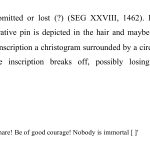| Artefact ID | 1295 |
| TM ID | TM 97446 |
| Findspot (DEChriM ID) | 68 (al-Filusiyya) | Class | Funerary element, Textual |
| Material | Stone |
| Writing medium | Inscription |
| Text content | Subliterary |
| Language | Greek |
| Description | SEG XXVIII 1462; SEG XXVIII 2126 descr.: Epitaph. Anthropomorphic stela of beach-rock. Name omitted or lost (?). Probably a piece of jewellery or a decorative pin is depicted in the hair and maybe the deceased was a woman. Above the inscription a christogram [chrism] surrounded by a circle is flanked by two Greek crosses. The inscription breaks off, possibly losing the name of the deceased. Same consolatory formula as in the other steles sharing the same provenance – a combination restricted to the northern coast of Sinai (el-Huweinat and el-‘Arish) according to Dahari & Di Segni 2009: εὐμοίρει, εὐψύχει, οὐδεὶς ἀθάνατος, “fare thee well, be of good courage, nobody is immortal”, usually accompanied by the name of the deceased in vocative. |
| Selection criteria | Christian terms/formulas/concepts, Christian symbols/gestures/isopsephy |
| Date from | 350 |
| Date to | 499 |
| Dating criteria | Dated 5th c. in Verreth 2006 but phrasing and palaeography of the whole group of stelae point to late 4th-5th c. according to Dahari & Di Segni 2009. |
| Absolute/relative date | Relative date |
| Archaeological context | Bought on the antiquities market after the cemetery of al-Filusiyya was looted in the early 70s. According to Dahari & Di Segni 2009: 125*, an antiquities dealer from Rafiah who acted as middleman sold twenty-two tombstones to Hassan Aqilan, a Jerusalem antiquities dealer. The latter sold fifteen tombstones to Danny Pinkus, an antiquities dealer from Jaffa, who then sold eight of his tombstones to Moshe Dayan, three of which were later purchased by the Israel Museum (reg. nos. 82.2.960, 82.2.961, 82.2.962); it is unclear what became of the others. |
| Accession number | Jaffa, Private collection Pinkus D 3674 |


 Json data
Json data




